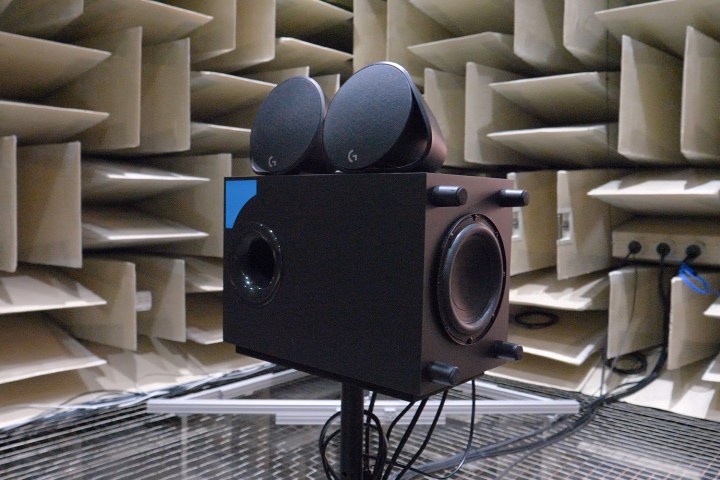
The PC is in decline. We’ve been hearing that story and seeing the numbers for years now, and we all know it’s true.
But in the midst of that decline, you might be surprised to hear how well a company like Logitech gets along. Despite its deep connection to PCs, the small, independent company continues to stay relevant in its many different ventures — whether that’s in high-end audio, or gaming peripherals.
We took a behind-the-scenes look at Logitech’s facilities in Camas, Washington to see how it thrives in a world where we rely less and less on PCs by the day.
A long history in audio
Logitech is known first and foremost as a PC mice and keyboard manufacturer. It was founded in the early 1980s in Switzerland — and by 2008, the company had sold over a billion mice. You’re bound to have used at least one of them in your life. But Logitech knew that if it wanted to grow, it’d have to expand beyond mice and keyboards.
The small, independent company continues to stay relevant in its many different ventures.
In 2001, Logitech acquired a competitor based out of Vancouver, Washington called Labtec, a company with a rich history in a desktop peripherals. Logitech didn’t have much experience in at the time: Computer speakers.
“That’s how we benefited for the heritage,” said Philippe Depallens, the VP of Logitech Audio, told Digital Trends. “We still have 15 [Labtec employees] from that era still with us. Logitech is very good at integrating different ingredients from different places. But also through the acquisition, we’ve been able to aggregate all the heritage that these guys have.”
After acquiring Labtec, Logitech quickly added audio devices to its suite of computer peripherals and began building up its own audio engineering facilities. Even though they both plug into a PC, engineering speakers is very different than mice or keyboards.
In order to support all these new ventures in audio, Logitech has continued to improve its testing facilities, bringing in the highest level of technology and industry practices, many of which rival what you’d see from a massive multinational conglomerate like Samsung or LG. The facility is filled with anechoic chambers, listening rooms, and compliance labs, all for the purpose of engineering some of the most advanced speaker systems in the world. The anechoic chambers, used for completely isolating sounds, are particularly fascinating, Logitech’s largest anechoic chamber even features a completely mesh floor to allow for a padded surface beneath. Spending too long in one of these chambers will make your ears tingle.
Even though they both plug into a PC, engineering speakers is very different than mice or keyboards.
On the other side of the spectrum, Logitech has built cozy listening rooms where they perform blind testing of its speakers. In the dark room of couches, listeners can switch between the different systems, as well as styles of music and volume. The idea is to give Logitech engineers an idea of what the average person hears, so they can make proper calibrations to the speakers based on how people actually experience the music.
But Logitech didn’t just build these advanced testing facilities for computer speakers. In addition to Labtec in the early 2000s, the company has made a couple of other important acquisitions — namely, Ultimate Ears (UE) and Jaybird. The two consumer audio companies, one for audiophiles and one for exercise, still maintain their own identity, but are now under the umbrella company of Logitech.
“As you know, the desktop speaker is a business that is currently declining,” said Depallens. “There is no secret around that. We have to embrace the new form factors and new behaviors.”
The addition of bluetooth speakers and headphones from these acquisitions have allowed Logitech to expand beyond the PC at a time when that’s more needed than ever.
Digging deep into gaming
The other big area where Logitech continues to thrive is in gaming. It’s one of the only areas of PC manufacturing where there is growing, not feigning interest. More importantly, it’s a demographic that is passionate about its peripherals, whether that’s mice, keyboards, speakers, or headphones. Logitech has caught onto that.
The first gaming products Logitech produced were the classic WingMan joysticks in the mid-1990s — an elegant weapon for a more civilized age. Nowadays, it’s all about Logitech G, the company’s new dedicated gaming brand. It was re-launched in 2013 with its refreshed mice and keyboards, all adding gaming style and performance to its products. Whether it’s affordable options like the Prodigy G203 or the wireless G903 Lightspeed, Logitech G has quickly become a mainstay in the gaming world and even show up on our list of the best gaming mice you can buy.
“We started to realize we could create a beautiful ecosystem around the desk between the mouse, the keyboard, and the speaker.”
Earlier this year, these two new ventures of gaming and high-end audio came together in one interesting product: The Logitech G560 Gaming Speakers. It’s first dip into the gaming speaker world, the G560 are certainly a unique take. Rather than just flashing LEDs in your face, the the G560 speakers use the backdrop of your room to enhance the gaming speakers. You can synch them up with games to fill the space behind your monitor with dynamic colors that actually reflect what’s happening within the game itself. They don’t come cheap, but with powerful sound (including a 2.1 subwoofer), it’s some fascinating innovation in a space that tends to remain fairly static.
“The easiest way for us to do this would have been to take one of our existing products, slap on a Logitech G logo, ship it, and just say this is a gaming speaker,”Depallens said. “That could have been our approach, but that’s usually not the approach we take.”

Logitech said it spoke to lots of gamers all around the world to see how they would actually use speakers around the desk, considering the popularity of gaming headsets.
“That’s when we started to realize we could create a beautiful ecosystem around the desk between the mouse, the keyboard, and the speaker,”Depallens said. “It’s about creating an ecosystem where not just the sound and the input is there, but also light. We realized that sometimes it’s easier to look to the right or left of your screen than it is to look down at your keyboard. That’s how the G560 was born.”
Syncing up with all sorts of different games, the lights on the speakers help set the tone of the gaming space — and in our experience, do add a special ingredient to make games more immersive.
Between high-end audio and new gaming products, we’re seeing a company can crank the volume on its strengths, without being left behind in this new era of how we use computers today.








